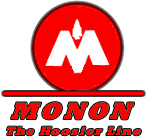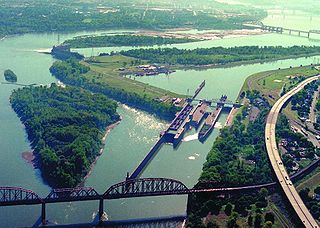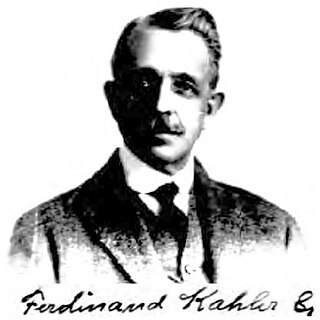
The Ohio Falls Iron Works was an industrial complex on Water Street in New Albany, Indiana. [1] The company manufactured iron bar and bridge iron, locomotives, cars, wagons, plows and other dimension irons. [2] Ohio Falls was founded in 1867.

The Ohio Falls Iron Works was an industrial complex on Water Street in New Albany, Indiana. [1] The company manufactured iron bar and bridge iron, locomotives, cars, wagons, plows and other dimension irons. [2] Ohio Falls was founded in 1867.
Ohio Falls was founded in 1867 by W. C. DePauw, President; Peter R. Stoy, Vice-President and Treasurer and John McCullough. DePauw had founded the American Plate Glass Works. Stoy operated a hardware house in new Albany. McCullough was a farmer and entrepreneur. [2]
Ohio Falls started with a paid-up capital of $200,000. The works were among the largest in the region, covering 260 x 400 feet of ground, the buildings equipped with steam power and a full complement of machinery. The capacity was 8,000 to 10,000 tons per year of finished goods. About 225 skilled iron-workers and laborers were employed, the payrolls ranging from $1,800 to $2,000 per week. [2]
Ohio Falls sold its products all over North America. [2] In a circular to the trade the company say:

New Albany is a city in Floyd County, Indiana, United States, situated along the Ohio River, opposite Louisville, Kentucky. The population was 37,841 as of the 2020 census. The city is the county seat of Floyd County. It is bounded by I-265 to the north and the Ohio River to the south, and is considered part of the Louisville, Kentucky Metropolitan Statistical Area. The mayor of New Albany is Jeff Gahan, a Democrat; he was re-elected in 2023.

The Falls of the Ohio National Wildlife Conservation Area is a national, bi-state area on the Ohio River near Louisville, Kentucky in the United States, administered by the U.S. Army Corps of Engineers in partnership with Indiana Department of Natural Resources. Federal status was awarded in 1981. The falls were designated a National Natural Landmark in 1966.

The Monon Railroad, also known as the Chicago, Indianapolis, and Louisville Railway from 1897 to 1971, was an American railroad that operated almost entirely within the state of Indiana. The Monon was merged into the Louisville and Nashville Railroad in 1971, and much of the former Monon right of way is owned today by CSX Transportation. In 1970, it operated 540 miles (870 km) of road on 792 miles (1,275 km) of track; that year it reported 1320 million ton-miles of revenue freight and zero passenger-miles.

The Union Station of Louisville, Kentucky is a historic railroad station that serves as offices for the Transit Authority of River City (TARC), as it has since mid-April 1980 after receiving a year-long restoration costing approximately $2 million. It was one of at least five union stations in Kentucky, amongst others located in Lexington, Covington, Paducah and Owensboro. It was one of three stations serving Louisville, the others being Central Station and Southern Railway Station. It superseded previous, smaller, railroad depots located in Louisville, most notably one located at Tenth and Maple in 1868–1869, and another L&N station built in 1858. The station was formally opened on September 7, 1891, by the Louisville and Nashville Railroad. There was a claim made at the time that it was the largest railroad station in the Southern United States, covering forty acres. The other major station in Louisville was Central Station, serving the Baltimore and Ohio, the Illinois Central and other railroads.

Falls of the Ohio State Park is a state park in the U.S. state of Indiana. It is located on the banks of the Ohio River at Clarksville, Indiana, across from Louisville, Kentucky. The park is part of the Falls of the Ohio National Wildlife Conservation Area. The exposed fossil beds of the Jeffersonville Limestone dated from the Devonian period are the main feature of the park, attracting about 160,000 visitors annually. The Falls was the site where Lewis and Clark met for the Lewis and Clark Expedition at George Rogers Clark's cabin.

The Sherman Minton Bridge is a double-deck through arch bridge spanning the Ohio River, carrying I-64 and US 150 over the river between Kentucky and Indiana. The bridge connects the west side of Louisville, Kentucky to downtown New Albany, Indiana.

The Fourteenth Street Bridge, also known as the Ohio Falls Bridge, Pennsylvania Railroad Bridge, Conrail Railroad Bridge or Louisville and Indiana (L&I) Bridge, is a truss drawbridge that spans the Ohio River, between Louisville, Kentucky and Clarksville, Indiana.

The Kentucky & Indiana Bridge is one of the first multi modal bridges to cross the Ohio River. It is for both railway and common roadway purposes together. Federal, state, and local law state that railway, streetcar, wagon-way, and pedestrian modes of travel were intended by the cites of New Albany and Louisville, the states of Kentucky and Indiana, the United States Congress, and the bridge owners. The K&I Bridge connects Louisville, Kentucky, to New Albany, Indiana. Constructed from 1881 to 1885 by the Kentucky and Indiana Bridge Company, the original K&I Bridge opened in 1886. It included a single standard gauge track and two wagon ways, allowing wagons and other animal powered vehicles to cross the Ohio River by a method other than ferry for the first time. At that time, motorized vehicles were virtually nonexistent. The K&I Bridge company also owned a ferry boat operation during both the first and second bridge; eventually that operation was sold as the bridge's success largely outmoded boat usage.

Louisville in the American Civil War was a major stronghold of Union forces, which kept Kentucky firmly in the Union. It was the center of planning, supplies, recruiting and transportation for numerous campaigns, especially in the Western Theater. By the end of the war, Louisville had not been attacked once, although skirmishes and battles, including the battles of Perryville and Corydon, Indiana, took place nearby.
The Julia Dean was the name of two river steamboats on the Mississippi River.

George Davidson Todd was Mayor of Louisville, Kentucky from 1896 to 1897.

Founded in Kansas City, Missouri in 1908, the American Automobile Manufacturing Company acquired the Jonz Automobile Company of Beatrice, Nebraska in 1910 with a planned initial capitalization of $1,000,000. In early news releases, the company claimed "$100,000 of the stock has been subscribed for by Chicago and Kansas City men". Initial plans called for the establishment of factories in Kansas City and Louisville, Kentucky.

The Louisville and Portland Canal was a 2-mile (3.2 km) canal bypassing the Falls of the Ohio River at Louisville, Kentucky. The Falls form the only barrier to navigation between the origin of the Ohio at Pittsburgh and the port of New Orleans near the Gulf of Mexico; circumventing them was long a goal for Pennsylvanian and Cincinnatian merchants. The canal opened in 1830 as the private Louisville and Portland Canal Company but was gradually bought out during the 19th century by the federal government, which had invested heavily in its construction, maintenance, and improvement.

Captain John Baptiste Ford was an American industrialist and founder of the Pittsburgh Plate Glass Company, now known as PPG Industries, based in Pittsburgh, Pennsylvania, United States.

The DePauw Avenue Historic District is a national historic district just northeast of downtown New Albany, Indiana, across the Ohio River from Louisville, Kentucky. The district consists mostly of Depauw Avenue from Vincennes Street in the west to Aebersold Drive to the east, and includes portions of the 1200 block of Beechwood Avenue and two residences on Vance Street. New Albany High School is located on the southern edge of the district.

The Vincennes Trace was a major trackway running through what are now the American states of Kentucky, Indiana, and Illinois. Originally formed by millions of migrating bison, the Trace crossed the Ohio River near the Falls of the Ohio and continued northwest to the Wabash River, near present-day Vincennes, before it crossed to what became known as Illinois. This buffalo migration route, often 12 to 20 feet wide in places, was well known and used by American Indians. Later European traders and American settlers learned of it, and many used it as an early land route to travel west into Indiana and Illinois. It is considered the most important of the traces to the Illinois country.

Stedman Machine Company is a manufacturer of crushing equipment in Aurora, Indiana, United States, that was founded by Nathan Rockwell Stedman in 1834.

Ferdinand Nickolas Kahler Sr. was an American inventor, entrepreneur and automobile pioneer who founded The Kahler Co. in New Albany, Indiana.

The Prather Site (12CL4) is a Middle Mississippian culture archaeological site located in the Falls of the Ohio region in Clark County, Indiana. It was the principal ceremonial center of the Prather Complex, the northeasternmost regional variant of the Mississippian cultures. It also bordered on several Upper Mississippian cultures, including the Fort Ancient peoples of Southern Indiana, Southern Ohio and Northeastern Kentucky.

The People's Transportation Company operated steamboats on the Willamette River and its tributaries, the Yamhill and Tualatin rivers, in the State of Oregon from 1862 to 1871. For a brief time this company operated steamers on the Columbia River, and for about two months in 1864, the company operated a small steamer on the Clackamas River.